Posts Categorized / Mothkeeping
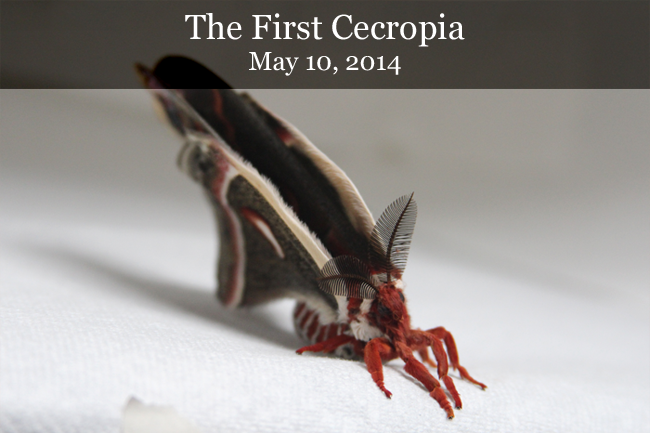
During the last few days, the larger cecropia pupa gave several signs eclosure was imminent. It began moving more. The pupa shell became fragile and paper-thin as the moth prepared to leave, and the abdomen swelled. By early Friday I was sure the cecropia would be out over the weekend. This morning, it turned itself in circles and periodically did what looked like sit-ups or crunches into the early afternoon. Just as I was starting to think it wouldn’t come out until tomorrow, I looked into the box after stepping out of the room briefly and saw six red legs flailing at the air. The little guy crawled up the paper towels to the top of the box and edged his way around the entire perimeter before settling in one spot to expand his wings.
Moths hang vertically to expand their wings, but I’ve turned these pictures 90° or 180° for ease of viewing:
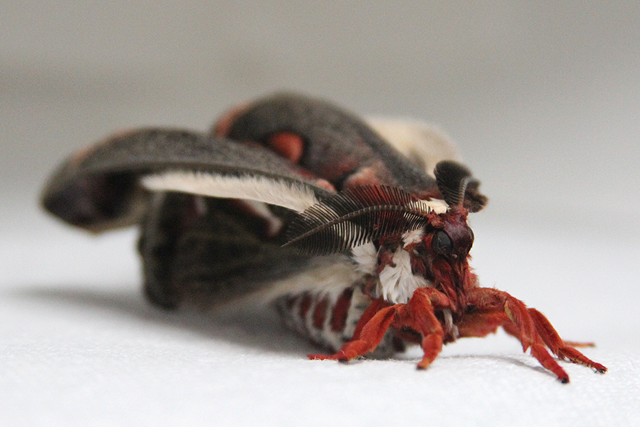
Freshly eclosed, looking damp and disheveled!
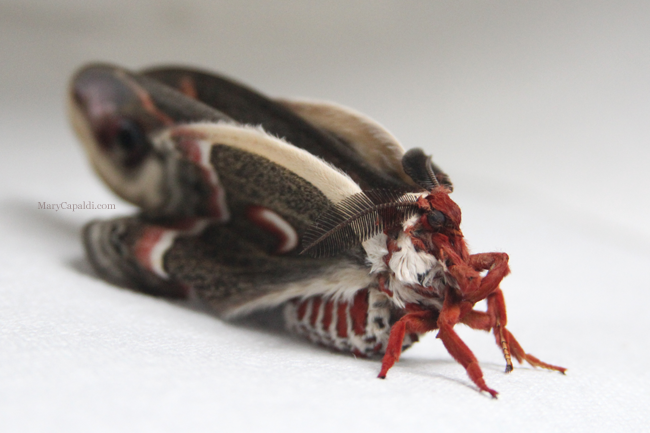
He crosses his front legs while his wings begin to uncurl and fill out.
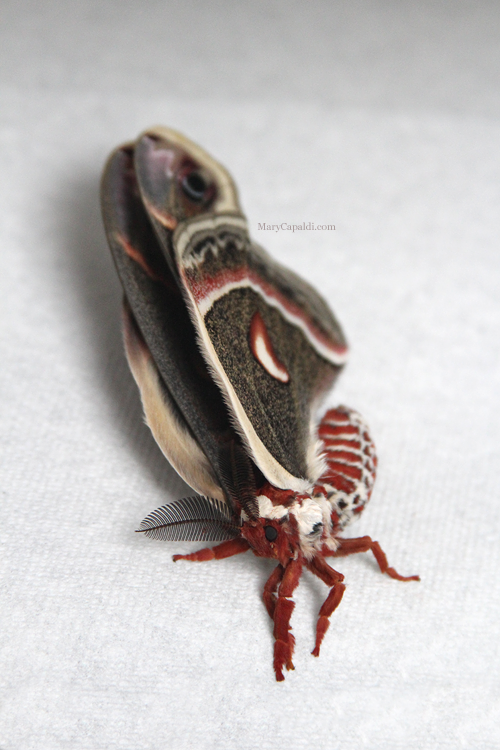
He leans to one side, then the other as everything gets into place.
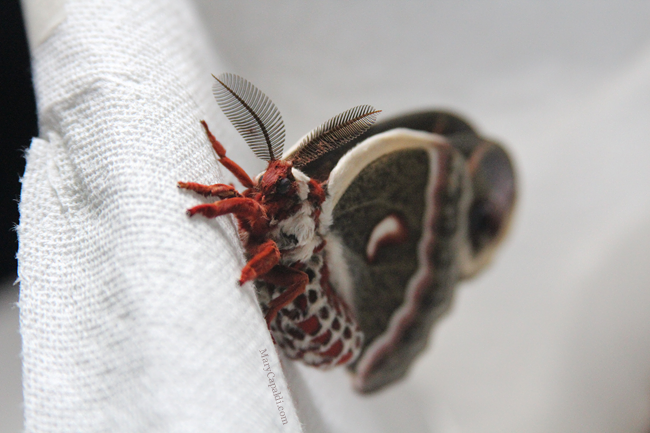
Handsome and ready to go!
He continued to rest in the same spot for several hours until the evening, when I decided to try some very gentle interaction. I put my hand in front of him but let him decide what to do. He slowly lifted one foot onto my fingers, then a second and third. I was about to leave him be when he flopped up onto my hand and went for a stroll halfway up my arm, batting his wings against me all the way. Turns out little moth feet pinch slightly – not enough to cause pain, but you wouldn’t miss one of these critters landing on your bare skin.
I let him step off in the safety of a large, fine mesh laundry basket with a frame. It affords him enough room to fly around a little while preventing him from slamming into anything dangerous. Before he settled in and let me close the lid, though, he took a spin around the room and managed to land squarely in one end of an upright cardboard tube I had propped against the wall. I scooped him up and returned him to the basket, where he will be spending the first night under the cover of a black tablecloth to block out any artificial light that might get him excited. I may try to come up with something larger still in the future.
I am so delighted to see one of my cocoons make it safely to adulthood and have high hopes for the others. For now, I have named this moth Cedric, and I’ll be taking many pictures of him!
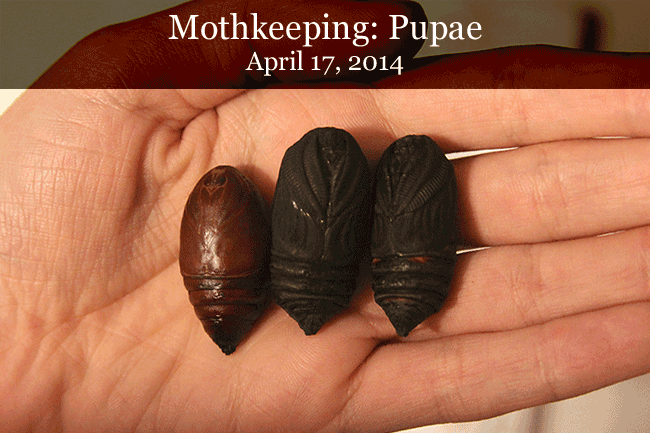
Warmth finally came to the east coast last week. This past Saturday, I decided to take the moths out of refrigeration. I’m using an eclosure setup based on Pinebaskets‘ guidelines – a plastic tub lined with paper toweling – though with a solid lid and a misting bottle on hand to prevent the bugs from getting dehydrated should the temperature outside drop enough to trigger the furnace. Most of the time I’m keeping them in a room that’s unheated altogether. It’s still too early to expect emergences anytime soon, but they get peeked on several times a day!
The moths weren’t out for long before my curiosity got the better of me, and I decided to open the cocoons. Silkmoth cocoons are like little sleeping bags for the changing creature inside, so it’s generally safe to open a cocoon as long as the pupa inside remains unharmed. Doing this also allows one to determine the sex of the moths before they eclose. I went very slowly with a pair of tiny nail scissors tilted away from the pupae. All three were alive and safe inside and have been doing well since.
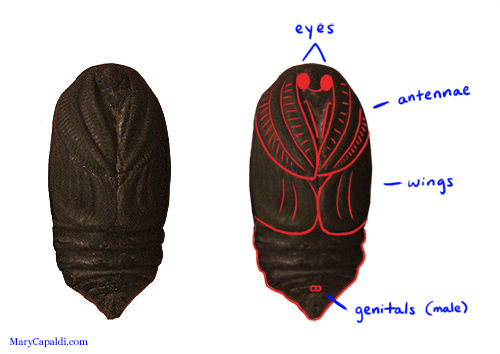
One of my Cecropia pupae with visible features identified.
Moth pupae are fascinating because you can see the features of the developing moth in the shape of the outside shell. The size of the antennae and outlines of the genitals reveal the sex, while the moth’s face, eyes, and wings are also visible on close examination. The wings look tiny compared to the whole body because they reach full size after the moth ecloses. My initial guess of one girl, two boys was off by a third: both of my cecropias and the luna are boys!
When exactly to expect eclosure is still uncertain. It can happen 1-3 weeks after the moths are removed from cold storage, which would mean late April to early May, but they could also take longer if spring temperatures continue to yo-yo. A mothing friend tells me females tend to come out before males, though I can’t test that myself this time. I do know that the moths will eclose in the morning. I’ll try my best to get pictures and/or video. The eclosure itself may be difficult to capture because it doesn’t take long, but even if I miss their first moments, there’ll be plenty of pictures of them as adults to share. Not so long now!
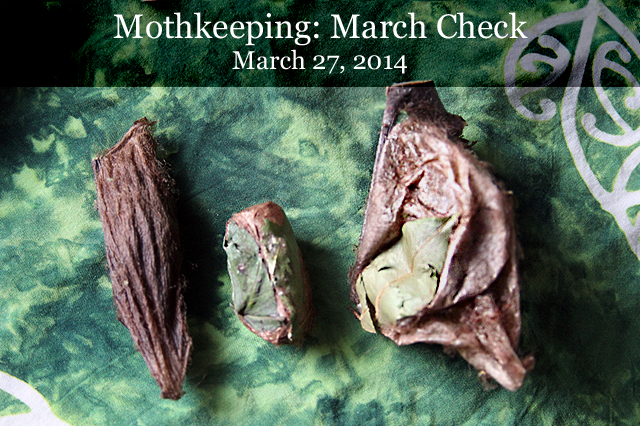
March comes in like a lion and goes out like a lamb, or so the saying goes. I was hoping to see early signs of spring sooner this month, as the last few years have been mild here, but it seems I expected too much of Mother Nature. We had a dusting of snow only a few days ago, and the week so far has been chilly. However, next week promises to be warmer, and the crocuses are coming up in the front yard. Perhaps April will reward my patience with budding trees and warmer temperatures. I am ready for my moths.
All three cocoons are doing well. I’ve given some thought to my eclosure setup since that time is approaching. With any luck, my next post will detail the final arrangement; spring should get around to settling in before much longer. If not, it will be May at the latest.

Getting tired of this snow!






 Posted by Mary in
Posted by Mary in 



